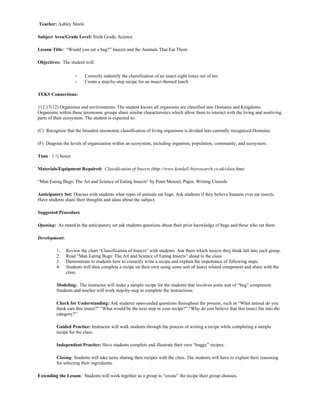
Sixth bug lesson
- 1. Teacher: Ashley Steele Subject Area/Grade Level: Sixth Grade, Science Lesson Title: “Would you eat a bug?” Insects and the Animals That Eat Them Objectives: The student will: - Correctly indentify the classification of an insect eight times out of ten - Create a step-by-step recipe for an insect themed lunch TEKS Connections: 112.17(12) Organisms and environments. The student knows all organisms are classified into Domains and Kingdoms. Organisms within these taxonomic groups share similar characteristics which allow them to interact with the living and nonliving parts of their ecosystem. The student is expected to: (C) Recognize that the broadest taxonomic classification of living organisms is divided into currently recognized Domains; (F) Diagram the levels of organization within an ecosystem, including organism, population, community, and ecosystem. Time : 1 ½ hours Materials/Equipment Required: Classification of Insects (http://www.kendall-bioresearch.co.uk/class.htm) “Man Eating Bugs: The Art and Science of Eating Insects” by Peter Menzel, Paper, Writing Utensils Anticipatory Set: Discuss with students what types of animals eat bugs. Ask students if they believe humans ever eat insects. Have students share their thoughts and ideas about the subject. Suggested Procedure Opening: As stated in the anticipatory set ask students questions about their prior knowledge of bugs and those who eat them Development: 1. Review the chart “Classification of Insects” with students. Ask them which insects they think fall into each group. 2. Read “Man Eating Bugs: The Art and Science of Eating Insects” aloud to the class. 3. Demonstrate to students how to correctly write a recipe and explain the importance of following steps. 4. Students will then complete a recipe on their own using some sort of insect related component and share with the class. Modeling: The instructor will make a sample recipe for the students that involves some sort of “bug” component. Students and teacher will work step-by-step to complete the instructions. Check for Understanding: Ask students open-ended questions throughout the process, such as “What animal do you think eats this insect?” “What would be the next step in your recipe?” “Why do you believe that this insect fits into the category?” Guided Practice: Instructor will walk students through the process of writing a recipe while completing a sample recipe for the class. Independent Practice: Have students complete and illustrate their own “buggy” recipes. Closing: Students will take turns sharing their recipes with the class. The students will have to explain their reasoning for selecting their ingredients. Extending the Lesson: Students will work together as a group to “create” the recipe their group chooses.